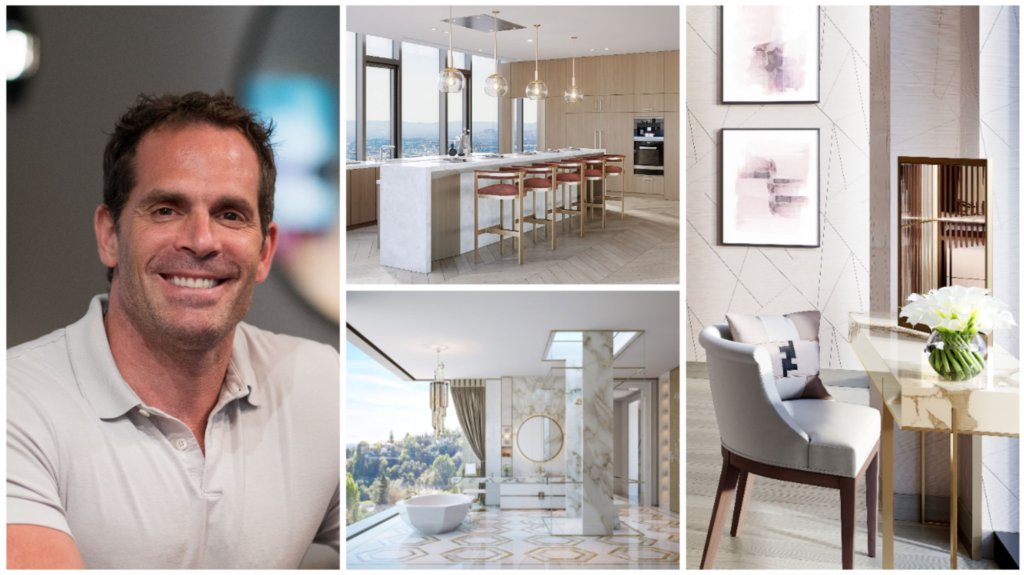Good Lighting Design Makes All the Difference, Says L.A.-Based Architect

British architect Gavin Brodin’s trademark is designing “luxury with ease,” where he connects lifestyle with architecture and interiors—all with an insane amount of attention to detail, and a clever use of natural materials.
Mr. Brodin is the founder of Brodin Design Build, a luxury residential and commercial property developer based in Los Angeles. Most recently, he and his team have completed the penthouses at the Four Seasons Private Residences Nashville, which are glass units on the top floors of the new development. (The top, 40th-floor residence breaks a Nashville record, on the market for $25 million.)
Some of his most notable works include private yachts, jets, urban apartments, and designing for celebrity clientele that include Rod Stewart, Sylvester Stallone and Kate Beckinsale.
Among his most ambitious portfolio projects are the $15 million Spelling Manor in Beverly Hills and the historic Palace Green mansion with 55 rooms on Kensington Palace Gardens in London, which he calls “one of my most memorable projects to date.”
Mansion Global caught up with Brodin, 50, about the power of lighting designers and the dangers of Pinterest.
Mansion Global: What was your approach for the penthouses at the Four Seasons in Nashville?
Gavin Brodin: As a designer, I’m always looking for projects that inspire and challenge me. This project allowed my team and I to tap into the traditional aesthetic of the Four Seasons, but with a modern, sleek design that would fit with the glass-encased penthouses they have on the Nashville skyline.
MG: Where do you feel luxury design is headed?
BG: We feel things are going toward lighter tones, simple designs, and natural materials that would stand the test of time, to keep it classic without overdoing the design. The Four Seasons is classic, but it’s more of an open, modern penthouse feel. People are not going for modern drywall boxes. A lot of people are asking for a similar design aesthetic, which is classic with modern elements. They bring in the color with the artwork, pillows, throws and flowers, but they keep the bones of the home very clean and transitional in its tones and style.
MG: What has been the biggest change in luxury design, in your eyes?
GB: Design has changed over the past few years. Before, we would meet a client and show the boards and samples. Now, everyone has a Pinterest board, it’s unbelievable how involved clients get showing you what they want. I’ve done this for almost 30 years, I’ve never seen anything like it.
MG: Is it overwhelming? You must add your own personal design trademark?
GB: Yes. They say: “I’d like this for the dining room, but this for the bedroom,” completely different styles, but we add a flow throughout the house. We give it our vibe throughout the house, and they love the outcome.
MG: Are people changing their design plans/layouts because of the pandemic?
GB: Somewhat, yes. They are trying to have multipurpose rooms. They want to maximize rooms, declutter and use every inch of every drawer, well-thought out. If you’re in a room, you can conceal power and USB cables in the leg supports of tables for work from home desks. People want good design, but everything seamlessly hides away. That’s what we’re seeing now. People want everything away from their kids, they don’t want cords on the tabletops. Organization is a massive priority.
MG: What’s your personal definition of luxury?
GB: For me, luxury goes far beyond high-quality craftsmanship. It’s really focused on the high level of detail of how the function of the home is tailored to the client. The amount of detail that goes into every area is part of luxury design. It’s a thought process, a use of the house. True luxury is considering how they live and move within a home, with flow and ease. That is true luxury for our clientele.
GB: No, it’s smaller homes with bigger outside space. People have gone less. We used to have clients coming in asking for 30,000 square feet and above, now they’re asking for 15,000 square feet. That was surprising. They were looking for smaller homes, bigger outdoor living, especially in California.
MG: Are you working in areas you haven’t worked before as luxury buyers moved over the past year and a half?
GB: We have an ongoing clientele. We do their homes every time they move. A lot of people moved to Nashville and Austin [in Texas] when the pandemic hit, which was super random.
MG: Who has been influential in shaping your design philosophy?
GB: The Canadian designer Ferris Rafauli, who is really into detail. I’ve done a lot of lofts, we don’t have a typical design aesthetic, we go from traditional to super raw.
MG: What’s luxurious about your own home?
GB: I just bought 5 acres of land on Mulholland Drive during the pandemic; I wanted this amazing piece of land. I’m going through my own designs right now of what I want. It’s going to be the “no separation” of indoor and outdoor. I like that natural raw look, a home right by a natural rock by the hillside. There are tons of bobcats and deer in the area. I’m donating half my land back to Santa Monica Conservancy so the animals can walk around freely.
MG: What’s the secret finishing touch of designing a fantastic home?
GB: Working with a good lighting designer is so beyond key, I can’t even tell you. Most people don’t understand the importance of a lighting designer. It’s the way they cast shadows. Most lighting designers get hired after the house has been built. It doesn’t make sense. They need to know every finish, every wall, where every coffee table is going to go, where mirrors and reflections are. Lighting design is built around that. It makes a huge difference.

